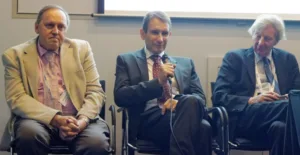Over the years, the EBU and DVB have normally held press conferences around the same time, but this year, the EBU didn’t have one, however DVB did.
Phil Laven the chairman of DVB started the press conference by saying that DVB is now 21 years old and has about 1.15 billion devices in use with the technologies developed by DVB. More than 60% of the world’s digital TVs use DVB technologies. Laven believes that the growth will continue.
There has been a lot of adoption of DVB-T2 from existing countries using DVB-T and other new digital users. HEVC will be widely adopted as a new compression system. In the US, the new ATSC 3.0 standard is “not quite” adopting DVB-T2 but is very close for the next generation of DTT in that region as it will adopt OFDM for modulation. It is using MPEG-DASH instead of DVB streaming over the carrier system. There is some chance of a single broadcast system for the world within a few years.
DVB-S and C are used universally around the world. Even DVB’s failures can be successes. The DVB had developed DVB-MHP as a platform for interactive TV, but was regarded as having failed (it was only adopted in Finland and Italy, to any great extent – Man. Ed.) Last year, Laven said, on a single day, 1 million devices including MHP were sold as the Sony PS4 uses the Gem software which includes MHP!
David Wood is chair of DVB’s committees on UHDTV and 3DTV. There are 15,000 channels of TV available around the world. He pointed out that “rubbish” programmes delivered in HD or UltraHD is still rubbish!
The new specifications for an HEVC receiver (either a TV or an STB) will be defined in a new version of the ETSI standard TS 101 154. The main requirements are to
* Decode up to 1080P 50 or 60Hz
* Two sub types – Rx 8 bits/sample or 10 bits/sample
* Support HEVC Main 10 Level 5.1
Meeting this requirement makes this a UHDTV Phase 1 Receiver and this is the technology for use in 2014/15.
* 4:2:0 components are the minimum level
* SD support is not mandatory
* HDTV colour primaries (Rec 709) are mandatory, but signalling for new ITU primaries (Rec 2020) is supported
* There is a tool to allow the possible use of high frame rates.
Wood believes that this level of technology is suitable for memory bandwidth today.
Looking to Phase 2, there will be more “quality factors” and features than Phase 1, Wood said. They will include
* Higher frame rates – up to 120Hz
* A mechanism for HDR signalling if the display can do it
* Possible scalable advanced sound system (e.g. Dolby Atmos or Fraunhofer spatial version)
It’s likely that the requirements for Phase 2 will be completed during 2015 and chips with the right bandwidth may not be available until 2017 or 2018. Questions about Phase 2 are around the relative value of different parts of the spec and whether UHDTV will be a “multiscreen” technology – i.e. splitting the screen between different views, which may work well for sport.
Wood said that 3DTV is “not forgotten”, but quiet. There have been no requests for 2160P S3D, yet, although they may come. Work is being done on this area and on 3D in a 1080P environment.
Peter Siebert was introduced as the technical guru on satellite technologies
DVB-S2, the satellite broadcast technology, was established 10 years ago, and the question was, can you improve it? The second question was, what could you do if you started again? After this discussion, some detailed changes have been proposed as DVB-S2X.
There are new technical details including channel bonding of up to three channels and this could be really useful as you can get 150Mbit streams which is good for statistical multiplexing of UltraHD.
There was no technology at the moment that can boost by 20%, the threshold for making a major technical change that needs a lot of investment, so DVB-S2 may never be replaced. In regions where high SNR is a problem, DVB-S2X will give a big boost in performance.
In response to questions it was said that Germany is seriously considering switching its DTT infrastructure to DVB-T2 with HEVC and optimised for indoor reception allowing 6-7 HD services with a capacity of 24 MBit. That may give a good future for DVB-T in Germany.
In another question, a comparison was made of broadcasting by DVB or by LTE technologies and Siebert made an impassioned response, pointing out that when LTE people talked about performance, they invariably chose the “best case”, whereas DVB always gives the “worst case”. He also pointed out the huge difference in the number of transmitters needed to cover the region that one DVB-T2 transmitter can cover.
Display Daily Comments
I noticed that the UHDTV Phase 2 requirements listed by David Wood did not include any colour specification. He agreed that the question of what colour gamut to support is a tough one. On the one hand, there are lots of sets that can already go beyond Rec 709 but on the other, nobody can make Rec 2020 displays, and cannot even work out how to without using lasers which nobody (apart from laser companies) wants! My view is that, given that there will eventually be some kind of standard that will match Super Hi-vision at 8K, Rec 2020 could be left until then. A decision to offer DCI-P3 would allow access to a lot more content from the cinema industry and make something that could be done with LCDs and quantum dots, as Dolby has demonstrated.
That would, at least, maintain some sense that “artistic intent” could be preserved for those that care about such things. (BR)


